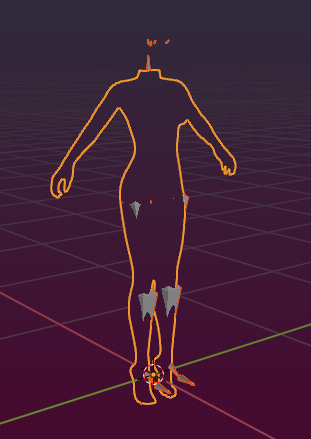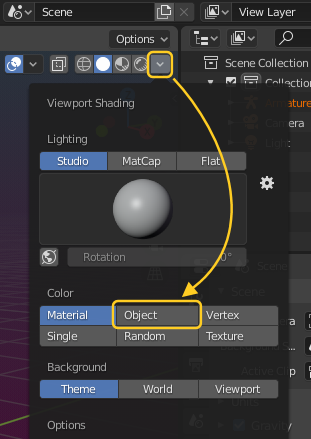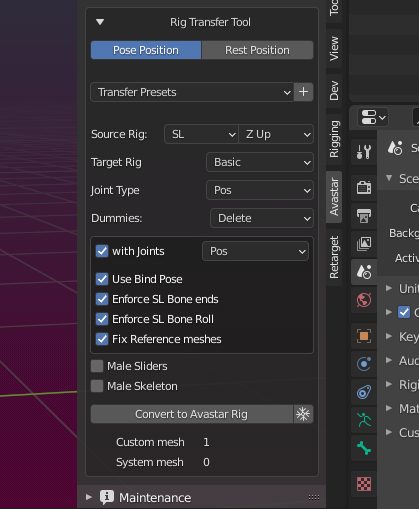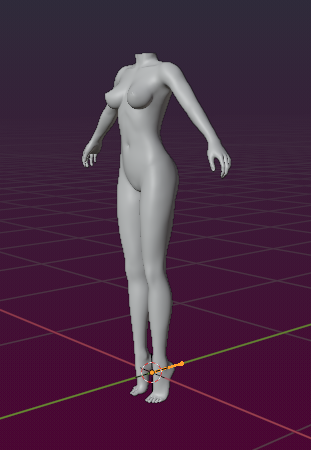Some creators of full mesh bodies provide Mesh Development Kits. These kits typically contain Reference Meshes and reference weight maps for the developing of body attachments (clothes).
This document explains how you can use the Avastar Rig Converter to get a development kit imported into Avastar.

Important: This document is a last resort when the Developerkit Manager fails!
We strictly recommend that you use the Avastar Developerkit Manager instead of using the Rig Conversion tool. Please read on only when the Developerkit manager fails for any reason. In that case please also report to us how the Developerkit Manager failed.
Disclaimer
If you are a Developer kit User
Whenever you run into an issue with a developer kit integration, we must strictly recommend you to ask the kit creator for help. It is important that the creator has kept their distributed working files up-to-date for use with Avastar. You may wish to suggest to the creator that they can contact us for help if they are not able to help you.
If you are a Developer kit Creator
We provide help with getting your kit to work with Avastar if – and only if – you send us a copy of your developer kit for inspection. Also we only check Developerkits which also provide Collada files. Otherwise we won’t be able to help you or your customers with any issue resulting from the usage of your developer kit.
Ok, so lets get started
Lets assume you got the Developer kit in some readable form, such as .obj (Wavefront) or .dae (Collada) file, .fbx file or even as ready made blend file. The models may already be rigged, or not, this does not matter, we also can work with simple unrigged mesh models. In general you will proceed as follows:
Try first with the Developerkit Manager
Really! We tell this often to remind you that the Developerkit Manager is the way to go. Anything else is meant to be a workaround (please report any failure to us!)
The Developerkit Manager should make the import of a Developerkit a snap when
- The Developerkit comes with Collada (.dae) files
- Each Collada file contains one rig and a set of related meshes
If this is true for your Developerkit, then the Developerkit Manager is by far better suited than the manual way described below.
ok, you want (or need) to take the long way
Open the blend file that contains the development kit meshes or import the development kit meshes to a fresh new Blend file (By using File -> import …).
For Collada Imports: When you import a Collada file then you must use the import options as indicated in the image aside. Anything elkse leads to serious problems during the conversion to Avastar.
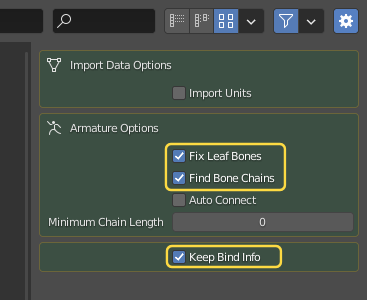
Now proceed depending on the properties of the development kit:
If the development kit is rigged to another Rig (most common case), then open the first toggle bar below.
If Your development kit comes with meshes only (rare) then open the second toggle bar below.
When Your development kit comes with its own Armature...
Migrate from foreign Rig
If your mesh Developer Kit is rigged to another (non Avastar Rig) then we have the Rig Transfer Tool for you. You find all details in the related documentation page:
The Rig Transfer Tool / Rig Update Tool is located in a subsection of the Rig Inspector panel (see image).
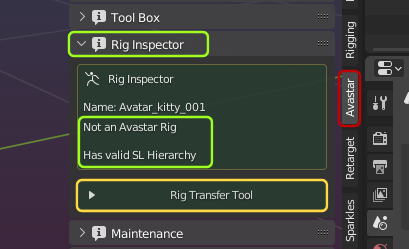
In brief terms you will proceed as follows:
- Open the blend file with the mesh development kit
or load the kit from Collada, fbx, … - Select the armature of the development kit in Object mode
- In the tool shelf, Avastar Tab, Rig Conversion Panel:
- Set the properties as necessary for your rig
- Click Convert to Avastar Rig
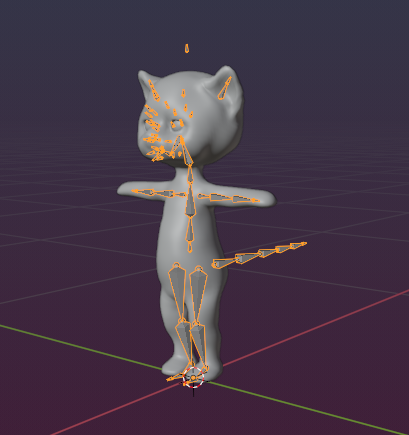
In our demo the Rig Inspector already classified the rig as a foreign rig (not Avastar) with a valid SL hierarchy, so it is possible to convert the rig to Avastar.

However, this tool is very complex and it is not fully fail proof. So you might need to try out a few settings before your results are good to go. See tips&tricks further down on this page for how to proceed when things go wrong.
For now just unfold the Rig Transfer Tool and configure…
Most important settings:
- Target Rig:
Basic for old avatar
Extended for Bento Avatar - Source Rig:
SL (good for almost all Developer Kits)
Avastar (update Avastar rig to new version)
Also check the Transfer Presets. Maybe your Developer Kit is already included there.

Look at the converted armature. Obviously the fingers are way to large. This is so because the original model (see above) did not have any hand bones. So Avastar has no information about where it should place the bones. Hence it takes the relative locations from the neutral SL skeleton.
In this case we have a tinie (70 cm high) so the default hands do not match with the body.

Important: If you do not enable the options shown above, then your imported rig has its leaf bones pointing all towards the global Y axis and the Rig Transfer tool might create odd results
Hint: If the automatic Rig conversion does not work, then you also can try to unbind the meshes from the armature, then proceed with the next toggle tab (When Your development kit comes with meshes only…)
Important: The following sections describe how to handle a Deverloperkit that only provides Meshes with weight maps but no Rig. If your model does not contain Weight Maps, then we do not count this as a Developerkit any more. In that case you better proceed with the Rig a Creature page
When Your development kit comes with meshes only...
Important: The following sections describe how to handle a Deverloperkit that only provides Meshes with weight maps but no Rig.
This situations is not very common. However it might be possible that you step into issues with converting a foreign rigged mesh to Avastar. In that case you can unbind the rigged mesh from its original rig, and then treat it as Deverloperkit without Armature. But as i typed above, this situation is very rare.
Rig a plain T-posed model without armature...
Applies to: not rigged Mesh that was made for the SL Restpose rig with neutral shape and having Weight maps
This is the simplest situation where you need to do almost nothing to get the mesh Deverloperkit to work with Avastar.
For this tutorial i made a creature that matches with the Secondlife default Armature in neutral Shape. The creature comes with ready made weight maps but without a rig.
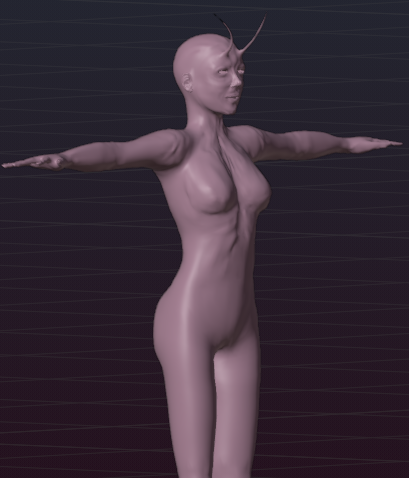
- Create a new Avastar
If your Deverloperkit contains a full character, then you probably want to create only the Rig.
But you are free to create the Avastar meshes along with the Armature. - In the Avatar Shape panel
locate the Shape presets row. There you also see 2 stick figures, one orange, one white. Select the white figure if your mesh was made for the SL neutral shape. - Check that the Avastar armature matches to the mesh.
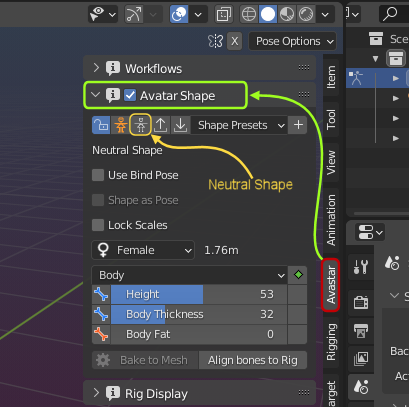
The white Stickman icon puts the Armature into SL Restpose Shape. This is what most Foreign Development kits support.
You must make sure that the rig matches to the mesh as tightly as possible. For our model this is the case when the rig is set to Neutral Shape (the white stick figure) which you can best see when inspecting the hand bones.
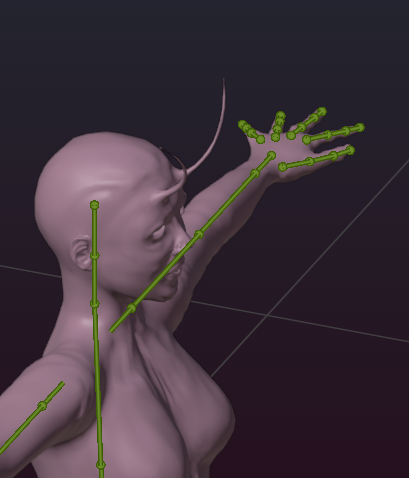
Note: It is possible that the mesh was made for another shape than the neutral SL Shape. This is often so when the Developerkit was made with Avastar as well (Avastar fully supports sliders). In that case you need to know which Shape was used to make the mesh. The Developerkit Creator will know.
If the Mesh now matches to the armature, then
- Bind your mesh to the Avastar rig with Preserve Weights
- And that’s all you need, your mesh character is now
ready to use with Avastar.
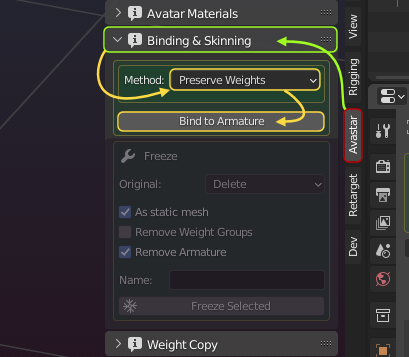
If the Mesh does not match to the armature, then
The Developerkit was made with its very specific shape. However that is no issue at all, at least when your Developerkit Creator can tell you which shape they used for their model.
If you know the shape, then proceed with the next tab ( Adjust the rig to a given Appearance Shape… )
Note: If you do not know the Shape, then you still can use the sliders to match the skeleton to the shape as good as possible.
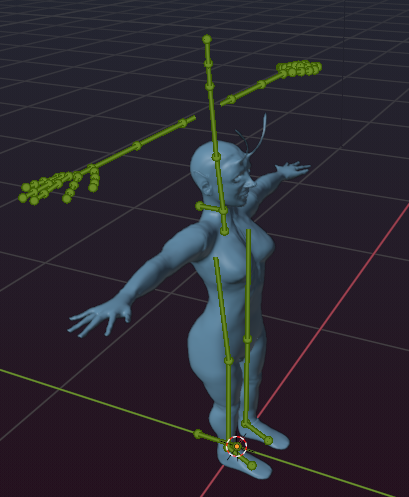
Model made with specific shape, while Armature uses White stick figure Shape.
Adjust the rig to a given Appearance Shape...
Applies to: not rigged Mesh that was made for a specific SL appearance Shape and having Weight maps
Sometimes the Mesh Deverloperkit has been made with a slightly modified rig that does not match exactly to the SL Original rig but has been made for a specific Appearance Shape.

In that case you need to adjust the Avastar Rig accordingly as follows:
Select the Avastar Armature in Pose mode. If you have the appearance Shape for which the mesh was made, then you can import this shape to Avastar.
If you do not have the Shape available then you still can use the appearance sliders directly adjust the bone length until the rig matches to the Mesh.
Note: If you can match the armature to your model only with Shape sliders, then there is no need to Edit the Armature!
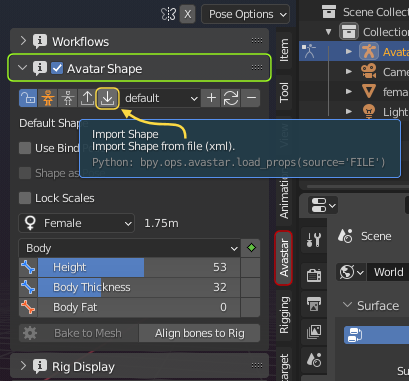
Hint: Once you have your Shape in Blender, you can add it as a new Preset by click on the white + sign right to the Shape Presets row.
If the Mesh now matches to the armature, then
- Optional add a new Appearance Shape preset
- Bind your mesh to the Avastar rig with Preserve Weights
- And that’s all you need, your mesh character is now
ready to use with Avastar.

If the above methods do not work for you, then you got a real problem. In that case the only chance to get the Developerkit to work is by calling the Creator and ask them for a complete model including a correct working Armature.
Note: Yes, you could try to adjust the Avastar Armature to the Mesh. This might work for simple cases. But in general any attempt to guess the Armature is very likely to fail, so you either ask the Creator for advise how to proceed or keep away from that Developerkit.
An example for importing a Foreign Development Kit into Avastar
There is nothing special about the Belleza Devkit. It just happens to be an ideal candidate for showing how to do a Migration in practice.
Step 1: Import the Devkit
- Open the Collada Importer by using:
File -> Import -> Collada
- Locate the Operator Redo Panel near to the top right corner of the File selection Window (See image). Please make sure that the following options are enabled (check marked):
Fix Leaf Bones
Find Bone
Keep Bind Info (importing Fitted Mesh Bones, see below)
Note: the Auto Connect option can be disabled in most cases. Please test what works best for your case!
- Import the Model
Important: The keep bind info feature is especially needed for development kits that are made for restposes other than the SL T-Pose. If you intend to import those development kits to Blender/Avastar, then please make sure that the Keep Bind Info option is enabled.
Note: If you ignore this Tip, then be prepared that your meshes will not look right in SL. Avastar can not export your meshes correctly in that case. Also you can not fix this later. So better get it right here and now.
Step 2: fix the Material settings (specific to Belleza)
Belleza has set up their models with a transparent material. So it is very likely that you see only the Outline of the Belleza Body.
The reason for this is that the Blender 2.8 Viewport has been improved a lot and it now can display advanced material options.
The good news: You can configure that…
- Open the Shading Options panel (upper right corner of the 3D Viewport)
- in the Color subsection select Object
- Now the Belleza Body appears again as usual
Step 2: Set the Migration options
- Select your Armature in Object mode (or Pose mode)
- Open the N-Panel and locate the vertical Avastar Tab
- Within the N-panel scroll down to the Rig Inspector
- Within the Rig Inspector locate the Transfer tool
- The Source Rig is SL with the Up Axis: Z
- The Target Rig can be Basic or Bento depending on what you want to do next. When in Doubt then select Basic.
- The Joint Type is Pos as far as we know.
- You probably do not want to have the Avastar meshes, so Dummies:Delete
- Belleza comes with an A Posed rig, you want to use Bind Pose and With Joints
- Since we are importing a female model, we keep Male Sliders and Male Skeleton unchecked
Important: For the male Belleza Mesh please enable Male Sliders but disable Male Skeleton
Now you are ready to click the Button Convert to Avastar Rig.


